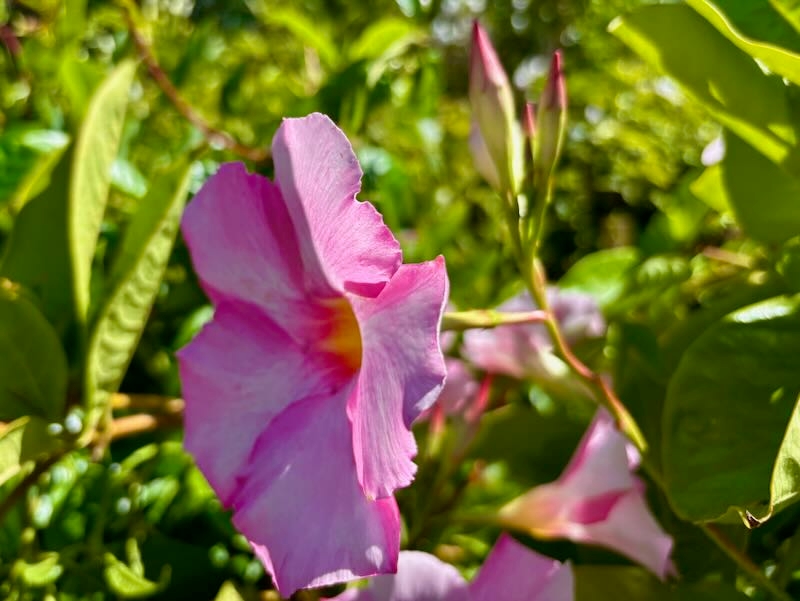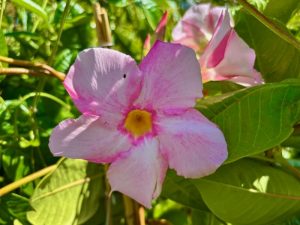Balcony Showstopper: Grow Mandevilla ‘Sun Parasol® Giant Pink’ For Endless Pink Trumpets
Mandevilla ‘Sun Parasol® Giant Pink’ starts any summer garden with a fanfare. This tropical vine pushes out extra-large, trumpet-shaped flowers in a soft shell-pink, each one centered with a golden throat that glows at dusk. The blooms look luxe, yet the plant works hard, climbing with twining stems and dressing a trellis, porch column, or balcony rail in glossy green.
Belonging to the Dogbane family (Apocynaceae), this modern hybrid, also sold as Sun Parasol Giant Pink Mandevilla, Mandevilla x ‘Sunmandecos’, and sometimes simply Pink Mandevilla Vine or Giant Pink Mandevilla, delivers color from early summer to frost. In frost-free climates it can flower nearly year-round. Plant it, give it sun and support, and enjoy a steady parade of five-petaled trumpets that shout “vacation” even on a weekday.
Meet the plant behind the spectacle
Mandevilla ‘Sun Parasol® Giant Pink’ comes from the famed Sun Parasol line bred for superior garden performance. As a group, Sun Parasol Mandevillas show excellent heat tolerance, strong disease resistance, and a long bloom window. ‘Giant Pink’ sits at the big-flower end of the series, with blossoms up to about 12–13 cm across (roughly 5 in). The petals open broad and slightly pointed, which gives each bloom a starry look, and the throat flashes yellow for contrast. Because the flowers arrive in succession, the plant always carries buds, open blooms, and a few fading trumpets at the same time, which keeps the show going.
The foliage matches the flowers. Leaves are deep green, lustrous, and elliptical. They hold well in heat and humidity, and they frame the blooms like polished leather. As the vine climbs, the canopy stays dense, which helps it read as a “living screen” on patios or along balcony rails. In warm regions (USDA Zones 10–11), the plant behaves as an evergreen climber. In cooler zones, gardeners treat it as a summer annual or overwinter it indoors.
Why gardeners choose Mandevilla ‘Sun Parasol® Giant Pink’
First, the color. The pink is refined rather than loud, which makes it easy to pair with White Mandevilla, Blue Plumbago, or Purple Princess Flower. Next, the size. Trained to a trellis, the vine can reach 3–4.5 m (10–15 ft) in one growing season outdoors, and 1.8–2.4 m (6–8 ft) in a large container, depending on your climate and feeding. Finally, the stamina. Flowers keep coming through heat waves that send other annuals into a sulk. As a bonus, the plant resists many common issues, including leaf spot in humid summers, when given good air flow.
You will find this same plant listed as Sun Parasol Giant Pink Mandevilla, Giant Pink Mandevilla Vine, Pink Dipladenia (a name many gardeners still use), and Mandevilla x ‘Sunmandecos’. Whatever the tag, you get the same big, glossy vine with oversized trumpets.
Habit, size, and seasonal rhythm
Expect a vigorous, twining habit. Stems spiral around supports rather than clinging with tendrils, so give the plant something to wrap—bamboo canes, nylon trellis netting, a metal obelisk, or fishing line strung on a frame. In the ground with rich soil and regular water, the vine can top 3–4.5 m (10–15 ft) tall and spread 60–120 cm (24–48 in) wide by season’s end. In containers, top growth tracks root volume; a 40–50 cm (16–20 in) diameter pot helps the vine reach 2–3 m (6–10 ft).
Flowering begins once nights stay reliably above 10 °C (50 °F). In many temperate gardens, that means early summer. Blooms continue to frost. In subtropical gardens near the coast or in Zone 10–11, the plant may pause in the coolest weeks, then resume flowering as soon as days warm.
Safety and handling notes
Like many members of Apocynaceae, Mandevilla exudes a milky latex sap. It can irritate skin and eyes. Wear gloves when you prune, and wash up afterward. Keep pets from chewing stems or seed pods. Gardeners rarely see significant wildlife browsing, which helps the vine hold its form in container displays.
How to grow Mandevilla ‘Sun Parasol® Giant Pink’: light, soil, and water
Start with light. Place the plant where it receives at least 6 hours of direct sun each day. Full morning sun with light afternoon shade works well in very hot regions, since strong late-day sun can scorch container roots. In cooler climates, give it sun all day to maximize flowering.
Next, focus on soil. In the ground, work 5–8 cm (2–3 in) of compost into the top 20–30 cm (8–12 in) of soil to improve drainage and fertility. Aim for a slightly acidic to neutral pH around 6.0–6.8. In containers, use a high-quality potting mix with added perlite or pine bark for air space. Avoid heavy garden soil in pots; it compacts and suffocates roots.
Then manage water. Keep the root zone evenly moist but never saturated. As a rule of thumb, water when the top 2–3 cm (about 1 in) of mix feels dry. On hot, windy days, especially on balconies, containers may need daily watering. Always drain freely; standing water leads to root rot. If you garden in a rainy climate, raise containers on pot feet and avoid saucers that collect water.
Finally, remember temperature and humidity. Growth slows below 10 °C (50 °F) and stops near 5 °C (41 °F). Frost at 0 °C (32 °F) damages foliage and flowers, so plant outdoors only after your last frost date. Humidity helps; in dry regions, group containers together to create a moister microclimate around leaves.
Planting and spacing for instant impact
Set plants out once nights hold above 10 °C (50 °F). In the ground, dig a hole twice as wide and just as deep as the nursery pot. Gently loosen circling roots, position the crown level with the surrounding soil, and firm in. Space multiple vines 45–60 cm apart (18–24 in) along a fence or trellis to build a continuous curtain of bloom.
For containers, choose a sturdy pot at least 35–40 cm (14–16 in) wide with generous drainage holes. Insert your support before planting so you do not damage roots later. Center the vine, backfill with potting mix, water thoroughly, and tie the main stems loosely to the support to guide early climbs.
Fertilizing Mandevilla ‘Sun Parasol® Giant Pink’ for nonstop blooms
Feed to fuel flowers. At planting, mix a slow-release, balanced fertilizer into the soil following label rates. During peak growth from late spring through mid-summer, supplement every 2–3 weeks with a water-soluble bloom formula. Many gardeners use a product with a higher middle number (phosphorus), but balance matters more than any single nutrient. Keep nitrogen moderate to avoid lush leaves at the expense of flowers. As nights cool in early autumn, taper feeding to once a month and stop before you move the plant indoors for winter.
Pruning and training your Mandevilla ‘Sun Parasol® Giant Pink’
Train early and prune often for shape. As stems extend, wind them clockwise around supports, adding soft ties where needed. Pinch back stem tips in early summer to encourage branching; more side shoots mean more buds. If the vine outgrows its space, reduce long stems by one-third. Make cuts just above a leaf node. Indoors at winter’s end, give the plant a harder reset by shortening lanky vines to 30–60 cm (12–24 in). That spring haircut triggers stout new growth and fuller coverage outdoors.
Overwintering indoors without losing your mind
In Zones 9 and colder, plan to overwinter. Before your first light frost, inspect the plant for pests and rinse foliage with a shower or hose. Move the pot to a bright window or a heated sunroom where temperatures stay above 10 °C (50 °F), ideally 15–21 °C (60–70 °F). Growth will slow. Water sparingly—about half as often as in summer—letting the top 3–4 cm (1.5 in) dry between drinks. Do not fertilize until days lengthen again. Expect some leaf drop the first few weeks indoors. As spring returns, increase water slightly, resume light feeding, and move the vine back outside after frost danger has passed.
Propagation: getting more plants the right way
Home gardeners can propagate for personal use; however, this cultivar carries a U.S. plant patent, so you may not asexually propagate it for sale without permission. For your own collection, take 10–15 cm (4–6 in) tip cuttings in late spring or early summer.
Choose non-flowering shoots, remove the lower leaves, and dip the cut base in rooting hormone. Insert the cutting into a small pot filled with moist, sterile propagation mix. Cover the pot with a clear dome or bag to hold humidity, then place it in bright, indirect light at about 21–24 °C (70–75 °F). Vent the cover daily to prevent mold. Roots usually form in 3–4 weeks. Once you see resistance when you tug gently, remove the cover, grow the plant on in bright light, and pot up after another two weeks.
Gardeners also root stems by simple layering. Coil a flexible side shoot down to a neighboring pot, nick the underside lightly at the contact point, and bury that section 2–3 cm (about 1 in) deep. Keep it moist. After roots form, snip the new plant free and grow it on.
Pests and diseases: prevention that actually works
Healthy, well-ventilated plants shrug off many problems. Still, keep an eye out. Spider Mites appear during hot, dry spells, leaving fine webbing and stippled leaves. Increase humidity, rinse foliage with a strong spray, and treat persistent infestations with horticultural oil. Mealybugs hide in leaf axils as white, cottony tufts; dab them with alcohol on a cotton swab or apply insecticidal soap weekly until they vanish. Aphids cluster on new tips, especially in spring. A blast of water or a single soap treatment usually clears them.
Root issues develop only in soggy soil. Prevent them with sharp drainage, careful watering, and breathable potting mixes. Leaf spot or mildew remains uncommon on ‘Giant Pink’, yet good spacing and morning sun help foliage dry quickly after rain. Always remove spent blooms and yellowing leaves to keep the canopy tidy.
Design ideas with Mandevilla ‘Sun Parasol® Giant Pink’
Because the vine blooms in a gentle pink, it acts as a bridge color. Pair it with Blue Plumbago for a seaside palette, or with White Petunias to make the trumpet throats glow at night. For tropical drama, weave stems through a bamboo teepee surrounded by Red Hibiscus in large tubs. On balconies, set a 40 cm (16 in) tall obelisk in a 45 cm (18 in) pot and let the vine swirl upward. The glossy leaves reflect evening light, and the pink flowers photograph beautifully, which matters if you share garden shots online.
The plant also excels as a privacy accent. Two containers spaced 90–120 cm (3–4 ft) apart on either side of a seating area create a living screen by mid-summer. Because the vine climbs rather than sprawls, the footprint stays small while the vertical coverage grows.
Container culture that keeps the roots happy
In pots, success starts with volume. Choose at least a 35–40 cm (14–16 in) diameter container for young plants, moving up to 45–50 cm (18–20 in) as the vine matures. Terracotta breathes but dries fast; glazed ceramic holds moisture but needs big drainage holes. A lightweight plastic pot works well on balconies where weight matters. Always elevate pots on feet to keep drains clear after summer downpours.
Water Mandevilla ‘Sun Parasol® Giant Pink’ deeply so moisture reaches the entire root ball. On a hot day, that might mean 3–4 liters (about ¾–1 gal) for a 45 cm (18 in) pot. Then wait until the top layer dries before watering again. If leaves turn yellow and drop from the bottom up, you likely overwatered; if they crisp and fall from the top down, the plant probably went too dry. Adjust and the vine will rebound.
Feeding schedule at a glance, explained in plain language
At planting, blend a slow-release granular fertilizer into the potting mix. Two weeks later, begin a liquid feed every 2–3 weeks. Continue through mid-August in cool climates or early September in warm ones. Stop feeding as nights drop below 12 °C (54 °F) and the plant prepares to rest. This rhythm pushes vigorous growth early, then supports heavy flowering just as the vine hits its stride.
Quick troubleshooting guide
No flowers? Increase light and check feeding. Too much nitrogen gives you leaves, not blooms. Sparse growth? Pot may be too small, or roots may be pot-bound. Step up one size and refresh the mix. Yellow leaves in midsummer? In containers, it often means uneven moisture; water more deeply but less often so the entire root zone drinks. Sticky leaves? Look for aphids or scale and wash them off before they spread.
Frequently asked questions gardeners actually ask
How tall will it get in my pot? With a 45–50 cm (18–20 in) pot and a sturdy trellis, expect 2–3 m (6–10 ft) of height by late summer. Can I plant it in the ground? Absolutely, if your soil drains well. In rich soil with sun, ground-grown vines can reach 3–4.5 m (10–15 ft) by fall. Will it survive winter outdoors? Only in Zones 10–11. Everywhere else, move it inside before frost. Is it deer resistant? Usually yes, thanks to the bitter latex sap, but hungry deer sample anything; protect new plantings until growth thickens.
The essentials of Mandevilla ‘Sun Parasol® Giant Pink’ in one tidy picture
This vine is a heat-loving, sun-chasing climber with big, fragrant-leaning (lightly scented) pink trumpets. It performs in containers and in the ground, provided you give it sun, support, and steady moisture with sharp drainage. Mandevilla ‘Sun Parasol® Giant Pink’ belongs to Apocynaceae, so it carries milky sap—handle it thoughtfully. In return, it rewards you with months of color and a glossy, tropical look that transforms small spaces.
Final planting recipe you can trust
Plant Mandevilla ‘Sun Parasol® Giant Pink’ once nights exceed 10 °C (50 °F). Place it where it will receive at least 6 hours of direct sun. Set it in a compost-enriched, well-drained soil or in a premium potting mix with added perlite. Provide a trellis or obelisk at planting time and tie new shoots gently as they lengthen. Water when the top 2–3 cm (about 1 in) of soil dries. Feed every few weeks through summer. Pinch tips to branch. Before frost, move containers indoors to a bright window and water sparingly. In spring, prune back to 30–60 cm (12–24 in) to reset shape, then move the vine back outside to start the show again.
Grow Mandevilla ‘Sun Parasol® Giant Pink’ once, and you will likely make space for it every summer. It climbs fast, blooms longer than almost any patio vine, and looks both elegant and exuberant—an irresistible combination for a gardener who wants instant impact with very little fuss.



